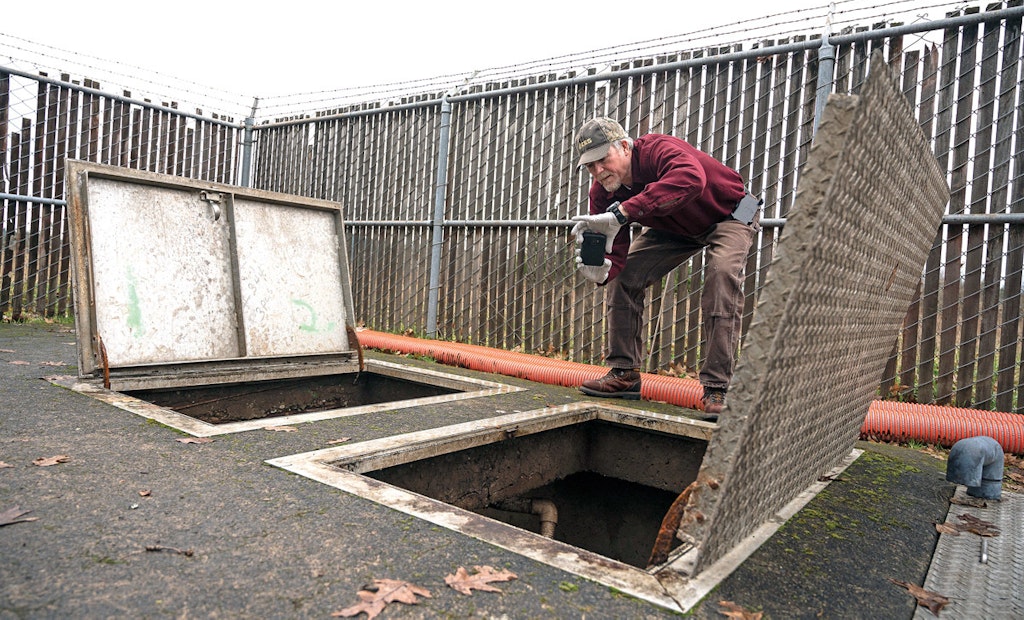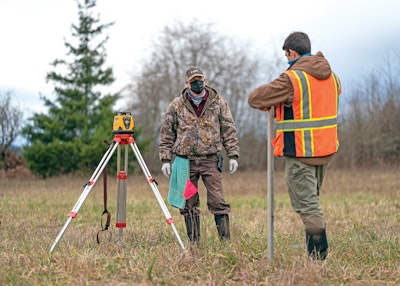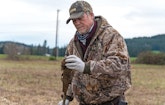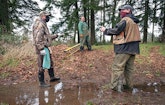
Brian Rabe takes photos during an inspection of a recirculation tank for a recirculating textile filter system from AdvanTex by Orenco. The system is in Oregon City, Oregon. (Photos by Ethan Rocke)
When it began, Cascade Earth Sciences had two purposes: onsite work and soil mapping. Over the past 44 years, there have been changes.
In 1998, Cascade was acquired by Valmont Industries. Founder Terry Rahe retired in 2006. Depending on customer demand and the experience of employees, the company branched out into other services such as land application, municipal biosolids, residuals management work for the pulp and paper industry, and bioremediation for mines, says Brian Rabe, the company’s managing soil scientist.
Through all these changes, Cascade remained true to its original purposes with new services never far from the core of the company, because everything Cascade does is about what happens at the intersection of water and soil.
FAR-REACHING SERVICES
Cascade is decentralized. Rabe works at the main office in Albany, Oregon. Other offices focus on jobs specific to their locations. One office, for example, is in Spokane, Washington, and works consistently with food processors, especially potato processors. Another staffer was on special assignment in China for a few years, working primarily on large-scale land application of process water, Rabe says.
Early in his career, Rabe designed systems for single-family homes. “I still, in select and unique circumstances, do things at the single-family-residence level. It’s not very often,” he says.
There was one client he helped in northeastern Oregon, a job notable because it was done remotely.
“I told him, when I first called him back, I don’t mean to sound judgmental, but I don’t think you can afford me because it would take me eight hours to drive there, and that cost alone would be prohibitive for a residential system,” Rabe says.
The customer still wanted Cascade, so they worked out an agreement. The customer collected information. Rabe made comments on it and worked on the design. This helped the customer and the regulator because the client intended to do his own installation. “And the regulator was concerned because there aren’t a lot of resources in that remote, rural part of the state, and it’s not the regulator’s job to consult,” Rabe says.
Work on community systems is uncommon in Oregon because of the state’s land-use and planning rules. Those push most development to urban and suburban areas where homes are often within reach of municipal sewer. Portland, Oregon’s largest city, has metropolitan planning, which adds another layer of review above the municipal governments.
“I’ve known installers who have told me if it’s work in Multnomah County (Portland), they’re going to add a 10% premium because they just know it’s going to be more time and hassle to get it done,” Rabe says.
He’s been working with a church there. After three years of review, the architect believes there is hope the project may soon go into final design.
LOOKING FOR A CHALLENGE
The projects Rabe likes best are those where the site has some limitation, typically soil depth or a high-water table. The advantage of being a soil scientist, he says, is being trained to think about how limited soil can be built up so it performs as it would on a good site. And Oregon has plenty of limitations, many of which involve a lack of water.
“Most people, when they think of Oregon, they think of the western side of the state as being wet and green,” he says. “When you get to the eastern two-thirds of the state, we’ve got parts of eastern Oregon that are true desert at about 6 inches of rain per year.”
Interesting projects can come about when other designers miss something. About five years ago, there was a job at a residential drug and alcohol treatment facility with a commercial kitchen and more cleaning and disinfection than is common in a typical home, he says.
“The system was struggling to perform as intended, and I think there may have been an underappreciation for the strength of the waste stream,” Rabe says.
BOD was more than 300 mg/L, which is Oregon’s upper limit for residential-strength waste, he says. Looking only at the hydraulic load, he says, a designer could have thought the installed units were properly sized, but calculating the mass load told a different story, because the manufacturer recommended a lower BOD for best performance. Rabe’s solution was to intercept water between the septic tank and the treatment unit and send it through a BioMicrobics HighStrengthFAST unit.
“We took the discharge from the FAST unit and ran it right back into the septic tank so that 24 hours a day we always had flow to our little side loop,” Rabe says.
What the modified system produces are small, continuous doses of wastewater moving through treatment. “We were designing to hit the maximum hydraulic limit of that treatment device spread out over 24 hours with little, tiny doses; I think it was on the order of 12.5 gallons every six minutes,” Rabe says.
MINDING MICROBES
What Rabe did there illustrates a core idea: Microbes do best when fed in small amounts around the clock.
“When I’m trying to explain it to people, I use the Thanksgiving meal as a comparison,” he says. “When you think about what most of us do at Thanksgiving, at 2 o’clock you fill your plate, and you can’t help but go back for seconds, and then dessert rolls around, and by the time you’re done you’re moaning and groaning, lying on the floor, trying to stay awake and watch a football game or visit. And you’re miserable because you’ve eaten so much at one time.
“If you were to take that same amount of food and start at 6 a.m. when you get up, and take a bite, walk around, come back in a few minutes and take another bite, and do that all through the day, you could actually eat more food and never be uncomfortable because your body can process little bits at a time. Microbes are the same way.”
Most of his designs try to achieve this steady state of little bites around the clock, he says. And there are many new components that enable this and weren’t available 30 years ago, he adds.
What Rabe does was inspired by Bill Stuth, inventor of the Nibbler, who introduced Rabe to the concept about 30 years ago. Stuth was big on putting in a surge tank and feeding wastewater through a system in small doses, Rabe says.
In any design, Rabe works first to meet permit limits, and then he considers soil loading. As soon as effluent reaches the soil, bacteria begin to build a biomat that restricts flow and becomes a limiting factor in drainage. In rapidly draining soils, it’s harder for a biomat to form, and that means less capture of pathogens and nutrients by the biomat, which means more nutrients and pathogens moving to groundwater, he says. That’s when you need low-pressure distribution, Rabe says, so effluent is spread out and there is more opportunity to capture pathogens.
MENTORS MATTER
Rabe credits much of what he is to the people he’s learned from. There’s Bill Stuth, of course, and there’s Dan Bush, who was once a regulator for Columbia and Clackamas counties and the state. Rabe recalls having lunch with him and Terry Rahe when Bush was thinking about starting his own business.
As a regulator, Bush saw many systems that were not maintained well and thought he could do better. He did start his own company, and over the next 20 years became an expert in operations and maintenance, Rabe says. Because he had a degree in biology and environmental health, Bush had a better understanding of onsite system function than most people, Rabe says. And because Stuth was one of Bush’s mentors, he was primed to think about dissolved oxygen, pH, and what kinds of microbes were present in a system at any given time.
“There’s folks out there who barely have a clue about what they’re doing, and then there’s folks who pay attention, go to school, and listen to folks like Dan, and strive to get better,” Rabe says.
A significant number of his designs, Rabe says, have been inspired by needs that Bush identified from his fieldwork.
Rabe grew up in a house with a septic system. As a child, he says, he was fascinated with biogas, built a digester in his bedroom using manure from the family’s animals, and was thrilled when he applied a match and saw the methane ignite. It fed the nerd in him, which is what work at Cascade does.
He learned what onsite systems are during a summer internship with the Oregon Department of Environmental Quality. Shortly after he graduated (and a couple of times after that) he was invited to join the state. But he took the job offer from Cascade, and he stayed.
“I have relationships with many of the regulators, and I’m sure I would do OK in that position, but I’m sure parts of their jobs would drive me nuts,” Rabe says. “What I would miss, and the part I really appreciate, is that creative side: coming up with a different way to do something, a new way to do it.”
Passing along onsite knowledge
Among all the day-to-day tasks, it’s easy to lose sight of what will happen to a business after retirement. Brian Rabe was intentional about the future for Cascade Earth Sciences in Albany, Oregon.
When Terry Rahe founded Cascade in 1976, it was with an emphasis on onsite wastewater and soil mapping. “So I said, I’ve carried the torch for all these years, and I don’t want that torch to go out when I leave,” says Rabe, the company’s managing soil scientist.
After 33 years at CES, he knows retirement is not that far in the future. So a few years ago, when he hired Chris Cotton coming out of Oregon State University with a master’s degree in engineering, Rabe was clear about his goal.
“When we were doing the interviews, I said the goal of this hire is to hire my replacement,” he explains. “I want the opportunity, with a few years of overlap, to download what’s between my ears to the next generation to carry the torch.”
In the beginning, he told Cotton as much as possible, using sketches, plans and worksheets from other projects to reinforce important details. As time went on, Rabe says, he talked less and released Cotton to do more work on his own, letting him ask questions when he needed help or wanted to learn more.
“I’ve seen too many people who either worked on their own or, when they retired, didn’t have that opportunity. And I’ve known a couple, like Dan Bush, who did an exceptional job of passing on their knowledge to the next generation,” Rabe says.








